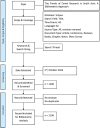Trends in camel research in South Asia: A bibliometric approach
- PMID: 39897368
- PMCID: PMC11784055
- DOI: 10.14202/vetworld.2024.2763-2773
Trends in camel research in South Asia: A bibliometric approach
Abstract
Background and aim: Camels play a crucial role in South Asia's cultural, economic, and ecological landscape. This study aimed to conduct a systematic bibliometric analysis of camel research from South Asia. This study sought to provide an overview of the topic's development and current and evolving themes by examining publication patterns, citation metrics, authorship trends, and thematic evolutions.
Materials and methods: The data for this study were obtained from the Scopus database. Bibliometric analysis was conducted using VOSviewer and the Bibliometrix package in R Studio to analyze publication trends, author productivity, collaboration patterns, journal impacts, keyword analyses, institutional contributions, and research outputs from individual countries.
Results: The bibliometric analysis of camel research in South Asia identified 1106 documents from 320 sources involving 2443 authors, with an international coauthorship rate of 16.91%. The primary clusters of research topics were camel biology and the veterinary sciences, focusing on the biological and health aspects of camels; camel milk and its products, emphasizing the role of camel milk in human nutrition and health; the genetics and molecular biology of camels; the pathogens and diseases of camels and their control; camel tissues and structures; and the effects of camel products on human health. India and Pakistan are the leading sources of such articles. Trending and evolving topics in camel research in South Asia continue to increase, forming a dynamic landscape. Key themes include growing interest in camel products' nutritional and therapeutic properties, particularly camel milk and bioactive compounds. The antioxidant and anti-inflammatory properties of camel products and their bioactive peptides have also gained research attention. The evolution from traditional studies of camel physiology and disease to molecular and genomic research underscores a shift toward a more detailed, mechanistic understanding of camel biology and health.
Conclusions: This bibliometric study highlighted the significant growth and diversification of camel research in South Asia over the past decades. The study emphasized the need for continued support and collaboration to gain knowledge of the unique attributes of camels and their regional and global benefits.
Keywords: South Asia; bibliometric analysis; camel research; publication trends.
Copyright: © Kandeel.
Conflict of interest statement
The author declares that he has no competing interests.
Figures












References
-
- Vijh R.K, Tantia M.S, Mishra B, Bharani Kumar S.T. Genetic diversity and differentiation of dromedarian camel of India. Anim. Biotechnol. 2007;18(2):81–90. - PubMed
-
- Faraz A. Portrayal of camel production in the desert ecosystem of Pakistan. J. Zool. Res. 2020;2(3):15–20.
-
- Butt A, Faraz A. Camel a true miracle:Extraordinary attributes, cultural significance and human roles. Int. J. Camel Sci. 2023;5:137–143.
-
- Sahoo A. Camel:A fast declining animal species but can strive with its unique climate resilience and “desert to medicine”. EC Vet. Sci. 2020;5:118–132.
-
- Mckenzie J.S, Dahal R, Kakkar M, Debnath N, Rahman M, Dorjee S, Naeem K, Wijayathilaka T, Sharma B.K, Maidanwal N, Halimi A, Kim E, Chatterjee P, Devleesschauwer B. One Health research and training and government support for One Health in South Asia. Infect. Ecol. Epidemiol. 2016;6:33842. - PMC - PubMed
LinkOut - more resources
Full Text Sources
Miscellaneous
